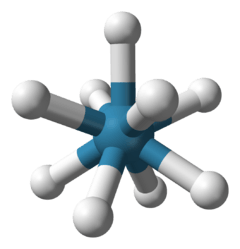Potassium nonahydridorhenate
Potassium nonahydridorhenate(VII) is an inorganic compound having the formula K2ReH9. This colourless salt is soluble in water but only poorly soluble in most alcohols. The ReH2−
9 anion is a rare example of a coordination complex bearing only hydride ligands.
 | |
| Identifiers | |
|---|---|
| Properties | |
| K2ReH9 | |
| Molar mass | 273.473 g/mol |
| Appearance | white solid |
| soluble | |
Except where otherwise noted, data are given for materials in their standard state (at 25 °C [77 °F], 100 kPa). | |
| Infobox references | |
History
The study of rhenium hydrides can be traced to the 1950s and included reports of the "rhenide" anion, supposedly Re−. These reports led to a series of investigations by A. P. Ginsberg and coworkers on the products from the reduction of perrhenate.[1]
The rhenide anion, Re−, was based on the product of the reduction of perrhenate salts, such as the reduction of potassium perrhenate (KReO
4) by potassium metal.[2] "Potassium rhenide" was shown to exist as a tetrahydrated complex, with the postulated chemical formula KRe·4H
2O.[3] This compound exhibits strongly reducing properties, and slowly yields hydrogen gas when dissolved in water. The lithium and thallous salts were also reported. Later research, however, indicates that the "rhenide" ion is actually a hydridorhenate complex. "Potassium rhenide" was shown to be in fact the nonahydridorhenate, K
2ReH
9, containing the ReH2−
9 anion in which the oxidation state of rhenium is actually +7.[4][5] Other methods of reduction of perrhenate salts yield compounds containing other hydrido- complexes, including ReH
3(OH)
3(H
2O)−
.[6]
Structure, synthesis, and properties

9 anion, a tricapped trigonal prism.
ReH2−
9 is an unusual example of a nonacoordinated complex, its high coordination number being attributed to the small size of the hydride ligand and the high positive charge on the Re(VII) center. Its structure consists of a tricapped trigonal prism,[7][8] as determined by neutron crystallography.[9][10] The diamagnetic sodium salt, like the analogous technetium compound, is prepared by treating an ethanol solution of sodium perrhenate, NaReO4, with sodium metal.[11] Via cation exchange, it can be converted to the corresponding tetraethylammonium salt, (N(C2H5)4)2ReH9.
Isostructural with TcH2−
9, ReH2−
9 consists of a trigonal prism with Re atom in the center and six hydrogen atoms at the corners. Three more hydrogen ligands define a triangle lying parallel to the base and crossing the prism in its center (see figure). Although those hydride ligands are not equivalent, their electronic structure is almost the same. The coordination number of 9 in this complex is the highest known for any rhenium complex.
References
- A. P. Ginsberg; J. M. Miller; J. R. Cavanaugh & B. P. Dailey (1960). "Evidence for the Existence of a Potassium Rhenium Hydride and its Bearing on the Nature of the (−1)-Oxidation State of Rhenium". Nature. 185 (4712): 528–9. Bibcode:1960Natur.185..528G. doi:10.1038/185528a0.
- Cobble, J. W. (June 1957). "On the Structure of the Rhenide Ion". The Journal of Physical Chemistry. 61 (6): 727–729. doi:10.1021/j150552a005.
- Bravo, J. B.; Griswold, E.; Kleinberg, J. (January 1954). "The Preparation of a Solid Rhenide" (PDF). The Journal of Physical Chemistry. 58 (1): 18–21. doi:10.1021/j150511a004. hdl:1808/26443.
- Floss, J. G.; Grosse, A. V. (1960). "Alkali and alkaline earth rhenohydrides". Journal of Inorganic and Nuclear Chemistry. 16 (1–2): 36–43. doi:10.1016/0022-1902(60)80083-8.
- Kenneth Malcolm Mackay; Rosemary Ann Mackay; W. Henderson (2002). Rosemary Ann Mackay (ed.). Introduction to modern inorganic chemistry (6th ed.). CRC Press. pp. 368–369. ISBN 0-7487-6420-8.
- Green, M. L. H.; Jones, D. J. (1965). Emeleus, H.J.; Sharpe, A.G. (eds.). Advances in inorganic chemistry and radiochemistry. Academic Press. pp. 169–172. ISBN 0-12-023607-9.
- Holleman, A. F.; Wiberg, E. "Inorganic Chemistry" Academic Press: San Diego, 2001. ISBN 0-12-352651-5.
- Housecroft, C.E. and Sharpe A.G. "Inorganic Chemistry" (2nd edn, Pearson 2005. ISBN 0130-39913-2), p.254
- Abrahams, S. C.; Ginsberg, A. P.; Knox, K. (1964). "Transition Metal-Hydrogen Compounds. II. The Crystal and Molecular Structure of Potassium Rhenium Hydride, K2ReH9". Inorg. Chem. 3 (4): 558–567. doi:10.1021/ic50014a026.
- Bronger, W.; à Brassard, L.; Müller, P.; Lebech, B.; Schultz, Th. (1999). "K2ReH9, eine Neubestimmung der Struktur". Z. Anorg. Allg. Chem. 625 (7): 1143–1146. doi:10.1002/(SICI)1521-3749(199907)625:7<1143::AID-ZAAC1143>3.0.CO;2-V.
- A. P. Ginsberg; C. R. Sprinkle (1972). Nonahydridorhenate Salts. Inorganic Syntheses. 13. pp. 219–225. doi:10.1002/9780470132449.ch45. ISBN 978-0-470-13244-9.
| Wikimedia Commons has media related to potassium nonahydridorhenate. |